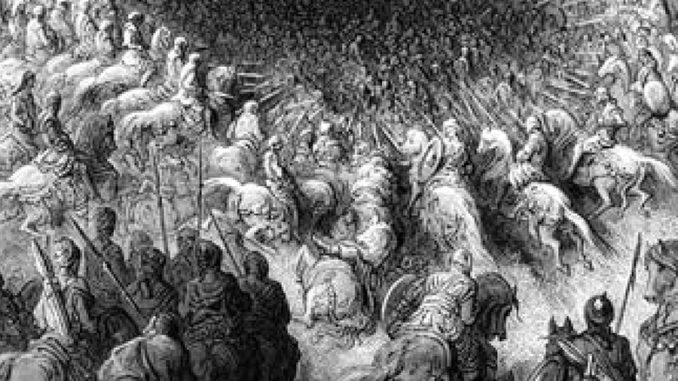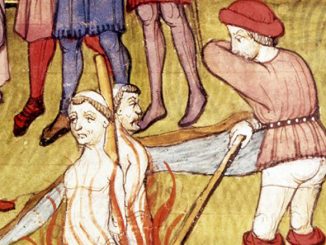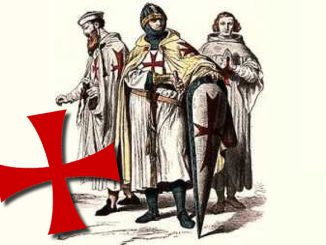
Above: Battle of Hattin by Gustave Doré
After the death of King Baldwin in 1186, Guy of Lusignan, his brother-in-law, took his place with the support of the Templar Knights. However, the Hospitallers wanted nothing to do with this unpopular King, and their Master withdrew his men from Guy’s ceremony in disgust.
One reason for King Guy’s unpopularity was his attack on a tribe of Bedouin shepherds in 1184. These shepherds had paid tribute to the Christians for grazing their sheep, but Guy and his men massacred many tribe members and drove the rest away with their flock.
Another despicable figure was Prince Reynald de Chatillon, who accompanied King Louis from France during the Second Crusade. While other crusaders returned home, Reynald remained, forming a selfish alliance with the Templars. His cruelty was notorious in the Holy Lands. He opposed the Emperor of Constantinople and attempted to blackmail him multiple times, which drew disapproval from the Patriarch of Constantinople, whom Reynald imprisoned. Reynald inflicted numerous cuts on the patriarch’s head, covered them in honey, and chained him to a rooftop where the sun and insects tormented him until near insanity. This cruelty would come back to haunt these two men in the summer of 1187.
The Battle of Hattin
The Fourth of July, a day for celebrating America’s independence from England in 1776, held a completely different significance in medieval Europe. On the Fourth of July, 1187, one of the bloodiest battles of the crusades took place: the Battle of the Horns of Hattin.
The area earned its name, the Horns of Hattin, from two rocky peaks that rose above the brush-covered slopes behind Tiberius on the Sea of Galilee. It was at this location that Saladin assembled 12,000 knights and an army carrying regular provisions. They were as well-mounted and armed as the combined forces of the Templar and Hospitaller orders. On the opposite side of the battlefield stood the crusading forces, consisting of 20,000 foot soldiers and about 1,000 knights. This smaller force was formed by depleting the troops from surrounding cities, leaving those cities vulnerable to attack.
The Christian army set out for Tiberius on the early morning of July 3rd, leaving behind their well-watered camp for the dryness of the desert air. They carried with them a sacred relic, the True Cross, discovered in 326 CE by the mother of Constantine the Great, for which many would later sacrifice their lives.
As they journeyed under the scorching desert sun, they found no water to quench their thirst. Wearing heavy armor, they must have been near exhaustion. By the evening of July 3rd, the crusading army reached a plateau below the Horns of Hattin, rising 100 feet above them. Even at this resting spot, the Templars and other crusaders found no water as the well was dry and the only stream blocked.
Fear gripped the men, and a sense of doom engulfed the crusaders. The Count of Tripoli, whose wife was held captive miles away, reportedly dismounted from his horse and cried out to the heavens, “Lord God, our war is over! We are nothing but dead men—and the Kingdom has come to an end.”
That evening, many men couldn’t sleep due to their desperate need for water. Some made the ill-fated decision to descend from the plateau in search of water, only to be captured and beheaded by Saladin’s men. In an act of torment, the Muslims set the dry grass ablaze, adding to the fear and suffering of the already parched and heavily armored soldiers.
By morning, Saladin’s forces had completely surrounded the crusaders. The chronicler of the event claimed they were trapped so securely that “not a cat could have slipped through the net.” Exhausted and outnumbered ten to one, the crusaders awaited their inevitable fate as the Muslim horns signaled the impending attack. Charging recklessly into battle, they faced certain death. Instead of engaging the Christians, Saladin’s army opened up their forces, allowing the crusaders to charge through. Once inside, Saladin closed the opening, sealing the crusaders’ fate.
The Saracen forces then launched relentless charges up the hill. The Christians fought back in silence, but Saladin’s blades claimed more and more lives from the crusading force. As the day wore on, only a few hundred Christian knights remained huddled around King Guy’s tent. Saladin’s son, witnessing this small group, falsely believed the infidels had been routed and informed his father. However, Saladin, who had declared that as long as the tent stood, victory had not been achieved, chastised his son. Inside the tent, a trembling Guy clung to the True Cross. Another Muslim charge soon brought the tent crashing to the desert floor.
Saladin’s Mercy
The leaders were then captured and taken to Saladin’s camp. The Muslim leader had set up a special tent for this purpose. The common soldiers were sold into slavery, with one Saracen reported to have had so many slaves that he was willing to trade one for a pair of shoes. Saladin showed no mercy to the Templars, except for their Grand Master, Gerard de Ridefort. Each Templar and Hospitaller was forced to kneel while Muslim soldiers beheaded them. None protested, and each met their death with profound silence and humility, as was the custom of their order. Many other soldiers, preferring death to a life of slavery under infidels, stepped forward, claiming to be Templars.
Inside Saladin’s tent, the barons were spared but required to pay a high ransom. King Guy of Jerusalem, parched and filled with fear, lay on the ground of the tent when Saladin offered him a bowl of water. Guy drank, quenching his thirst, and then offered the water to Reynald, who also longed for a drink. In response, Saladin abruptly rose, knocking the bowl and its contents from the Prince of Antioch’s hands. According to Muslim hospitality, once a man ate or drank with you, his life was safe in your hands. This act appeared to secure King Guy’s safety while sealing Reynald’s death sentence.
Infuriated by Saladin’s behavior, Reynald defamed the Islamic prophet Muhammed, prompting Saladin to draw his sword and sever Reynald’s arm in a single blow. Before the limb could touch the floor, a soldier entered and decapitated Reynald. Saladin then turned to King Guy of Jerusalem and assured him, “Have no fear. It is not the custom of kings to kill kings.” King Guy was released the following year from a prison in Nablus as a broken man, but perhaps not as shattered as the crusaders and Templars who suffered defeat in the Battle of Hattin.
About Us
We hope you enjoyed this article on the Battle of Hattin
TemplarHistory.com was started in the fall of 1997 by Stephen Dafoe, a Canadian author who has written several books on the Templars and related subjects.
Read more from our Templar History Archives – Templar History



